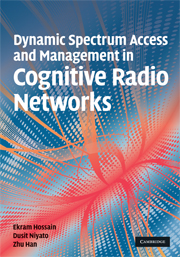2 - Introduction to cognitive radio
from Part I - Introduction
Published online by Cambridge University Press: 26 February 2010
Summary
Cognitive radio is a new paradigm of designing wireless communications systems which aims to enhance the utilization of the radio frequency (RF) spectrum. The motivation behind cognitive radio is the scarcity of the available frequency spectrum, increasing demand, caused by the emerging wireless applications for mobile users. Most of the available radio spectrum has already been allocated to existing wireless systems, however, and only small parts of it can be licensed to new wireless applications. Nonetheless, a study by the Spectrum Policy Task Force (SPTF) of the Federal Communications Commission (FCC) has showed that some frequency bands are heavily used by licensed systems in particular locations and at particular times, but that there are also many frequency bands which are only partly occupied or largely unoccupied [110]. For example, spectrum bands allocated to cellular networks in the USA [111] reach the highest utilization during working hours, but remain largely unoccupied from midnight until early morning.
The major factor that leads to inefficient use of the radio spectrum is the spectrum licensing scheme itself. In traditional spectrum allocation based on the command-and control model, where the radio spectrum allocated to licensed users is not used, it cannot be utilized by unlicensed users and applications [5]. Due to this static and inflexible allocation, legacy wireless systems have to operate only on a dedicated spectrum band, and cannot adapt the transmission band according to the changing environment. For example, if one spectrum band is heavily used, the wireless system cannot change to operate on another more lightly used band.
Information
- Type
- Chapter
- Information
- Publisher: Cambridge University PressPrint publication year: 2009
Accessibility standard: Unknown
Why this information is here
This section outlines the accessibility features of this content - including support for screen readers, full keyboard navigation and high-contrast display options. This may not be relevant for you.Accessibility Information
- 2
- Cited by
